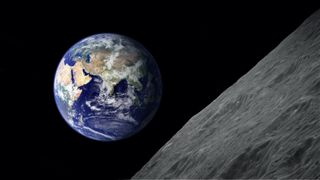
Will Earth ever lose its moon?
The moon is slowly creeping away from Earth, but will we actually lose the moon before the sun turns into a red giant and destroys us both?

The moon's orbit around Earth appears so regular that civilizations have based the month on lunar motion for thousands of years. However, the moon is actually creeping slowly away from Earth. So will Earth lose its moon at some point?
Scientists determined the rate at which the moon is drifting away from Earth with help from reflective panels that NASA placed there during the Apollo missions. For more than 50 years, researchers have fired laser beams from Earth at these mirrors and measured how long it took to detect the reflected pulses. Using the speed of light, scientists estimated that the moon is straying away from Earth by about 1.5 inches (3.8 centimeters) per year, roughly the rate at which fingernails grow, according to NASA.
The moon is moving away from Earth because of the gravitational effects that each has on the other. The moon's gravitational pull forces Earth's oceans to bulge toward it, resulting in the lunar tides, NASA said. Earth's gravity causes similar tidal effects on the moon, making our natural satellite slightly football-shaped.
The gravitational pull from Earth's tidal bulge drags on the moon. Meanwhile, the oceans shift because of the lunar tides, exerting friction on Earth's surface and thus slowing the planet's rotation, Madelyn Broome, an astrophysicist at the University of California, Santa Cruz, told Live Science. About 4.5 billion years ago, "when the moon was first formed, the rotation rate of the Earth would have been significantly faster, with a day length of about five hours," Broome said.
Related: Who owns the moon?
All of these forces work to sling the moon farther away from Earth.
"Since the Earth and the moon are part of the same gravitationally interacting system, total angular momentum must be conserved — stay the same — between the two," Broome explained. "Angular momentum describes the energy contained by something that is spinning. The faster you spin, the more angular momentum you have. The slower you spin, the less."
Sign up for the Live Science daily newsletter now
Get the world’s most fascinating discoveries delivered straight to your inbox.
However, "it's not just the rate of spinning that affects angular momentum," Broome added. "How far you are from the center of the system also matters. Further means the angular momentum of the system goes up. Closer means your angular momentum goes down. "
In the case of Earth and the moon, "as the Earth's spin slows down, in order for angular momentum to be conserved, something has to increase the angular momentum of the system," Broome said. "What increases angular momentum? An orbiting object like the moon getting further away."
The moon likely formed from debris that resulted from a crash between the nascent Earth and a Mars-size object, according to The University of Arizona. Tidal forces have helped pull the moon to its current average distance of about 238,855 miles (384,400 kilometers) from Earth, according to the Royal Observatory in Greenwich, England.
Tidal effects are also slowing the rate at which the moon rotates on its axis, resulting in the moon "tidally locking" with Earth — that is, always displaying the same face to our planet. These forces are also reducing the speed at which Earth spins.
In about 50 billion years, Earth's slowing rotation would make it tidally lock with the moon so that Earth would permanently show just one side to the moon, Jean Creighton, director of the Manfred Olson Planetarium at the University of Wisconsin-Milwaukee, told Live Science. At this point, the moon and Earth would stop moving away from each other, Eric Klumpe, a professor of astronomy at Middle Tennessee State University, told Live Science.
However, about 5 billion years from now, as the sun begins to die, it will swell to become a red giant star, "at which point the Earth-moon system will almost certainly be disrupted and destroyed," David Trilling, chair of the Astronomy and Planetary Science Department at Northern Arizona University, told Live Science.
In about 5 billion years, if the moon keeps drifting away from Earth at its current rate of retreat, the moon will have moved about another 117,000 miles (189,000 km) away when it gets consumed by the red giant sun, Broome said.
All in all, the moon will not leave Earth, or vice versa. Rather, the sun will obliterate them both.

-
Baryonyx If any intelligence runs the Solar System gigayears from now, planetary engineering to adjust Earth's orbit should be easy.Reply
